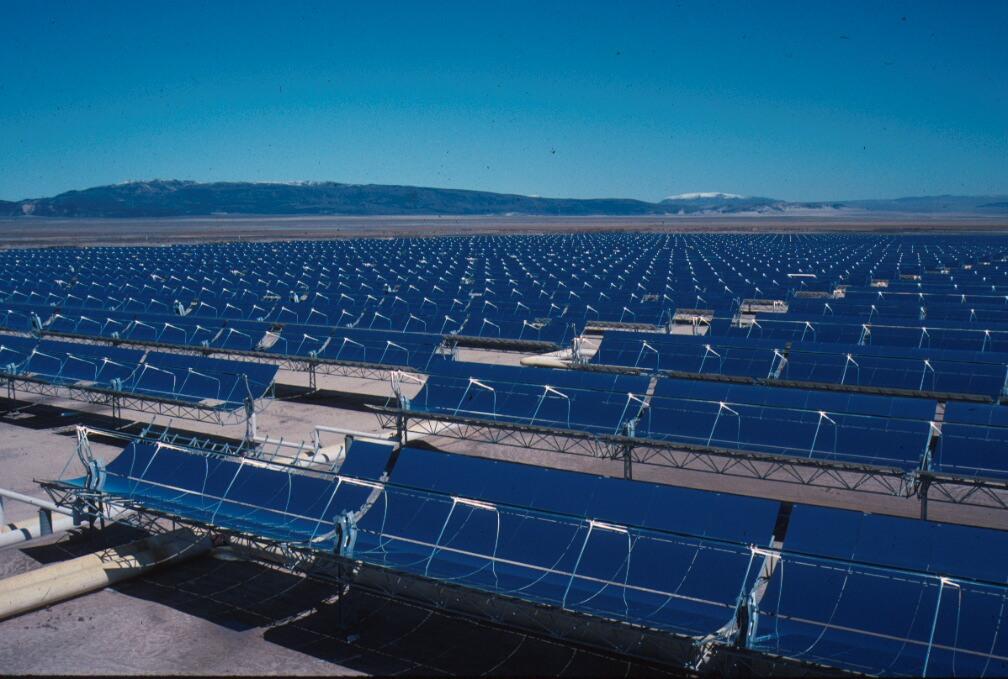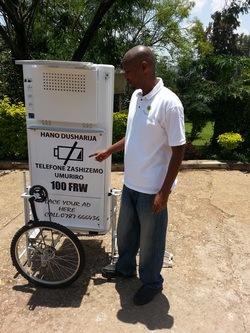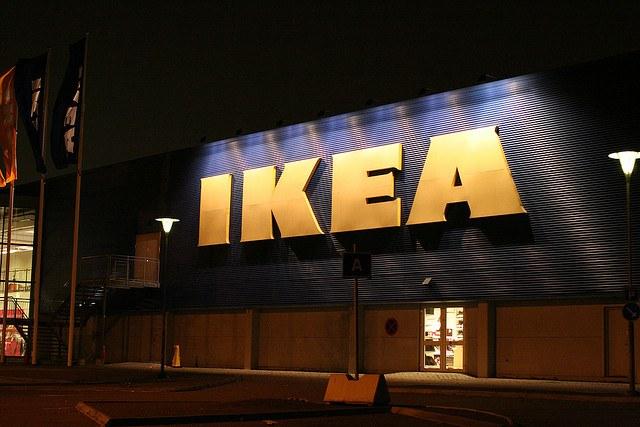The Top 10 Solar States: You May Be Surprised


The clean energy sector has been on an economic roller coaster the past several years, but despite entrenched interests, questions about efficiency and costs, renewables are on the upswing in the U.S.
That includes solar power, which is experiencing a surge in installations large and small—witness SolarCity’s success in recent years. Of course, the regulatory environment has a lot to do with how solar is spread.
So to that end, the writers at Solar Power Rocks, a clearinghouse of solar information from rebates to technology, recently ranked the U.S. states and the District of Columbia. The top 10 solar states may just surprise you—unless you live there and you have seen what is going on in your local community.
In order to gauge the winners and laggers on the solar power front, Dan Hahn and Dave Llorens, the brains behind Solar Power Rocks (SPR), looked at a bevy of factors, including each states renewable portfolio standard (RPS), the cost of electricity, rebates and credits related to solar, tax exemptions and regulations related to grid connectivity.
The top three, and five of the top 10 are in the northeast. New York comes out at #1, due to its wide array of financial incentives available to install solar, and what SPR describes as the “most aggressive RPS in the country.” Massachusetts and Connecticut, however, are not far behind, because of the Bay State’s fast payback time and CT’s generous solar rebates.
Oregon comes in at #4, mostly because of its financial incentives available for the installation of solar and an RPS pushing utilities to include one-fourth of their energy supplies from renewables by 2025. On a side note, Oregon is always an interesting state to watch. For example, it was the first state in the country to build solar arrays along public highways—creating energy in a space that otherwise sits empty.
Rounding out the top five is New Jersey. The Garden State has been pushing businesses and residents to consider clean energy for a decade, and stands out for its tax exemptions as well as one of the most robust Solar Renewable Energy Credit (SREC) programs in the country.
The next five, for the most part, should not raise too many eyebrows. Even though Colorado’s more generous solar rebates have run dry, the state ranks at #6 and offers residents and businesses a strong mix of incentives. Next is Maryland, which boasts a quick payback period for solar along with a strong RPS. Minnesota, however, leaped 14 spots to #8, largely because of its specific requirements for solar energy generation in the state, also known as its “carve out program.” Tiny Vermont and New Mexico come in with the ninth and tenth rankings.
What may startle some readers is the fact states such as California and Hawaii are not in the top 10, though #12 and #17, respectively, for those states is not too shabby.
As for the bottom six, well, they are either big coal-producing states or have barely any laws or incentives on the books. Kentucky and West Virginia are listed at #46 and #47, with Alabama, Oklahoma and Arkansas taking the next few rankings. Idaho is last in line at #51.
Granted, this list is subjective. Those who are only concerned about the amount of energy generated from the sun can take a look at the Solar Energy Industries Association’s list. Naturally, California ranks number one thanks to its size, but Arizona, North Carolina and Texas make the top 10—which shows that while regulations, incentives and laws make a difference, sunshine is still a factor on where solar panels make their appearance on the local landscape.
After a year in the Middle East and Latin America, Leon Kaye is based in California again. Follow him on Instagram and Twitter. Other thoughts of his are on his site, greengopost.com.
Image credit:BLM
SAP Twitter Chat on Millennials & Social Entrepreneurship: #SAPsocent


On Thursday, October 23rd at 9am PDT / Noon EST, TriplePundit and SAP led a Twitter Chat on millennials and social entrepreneurship at #SAPsocent.
This facilitated discussion examined how millennial entrepreneurs are transforming their industries and communities with new social enterprises. We spoke with experts and millennial entrepreneurs themselves about how the younger generation approaches bringing meaning to their daily work and building sustainable businesses from the ground up - and SAP shared its approach to supporting these young leaders. Bill McDermott, CEO of SAP, even stopped in to give his two cents!
Stepped out of CEO Summit to check out the convo here. We are talking about social contract between generations wCEOs. #SAPsocent
— Bill McDermott (@BillRMcDermott) October 23, 2014
Our guest speakers comprised a diverse, global panel of entrepreneurs and practitioners. The four agreed that the millennial generation is a different breed, and that the traditional workplace is changing as a result of technology and their desires to make an impact in the world.
- Tiago Dalvi, Founder and CEO of Solidarium, which markets products made by impoverished artisans to retailers such as WalMart:
- @dalvitiago: We’re focused in building businesses with cause. It’s possible to make money and change the world at the same time.
- Jacob Rosenbloom, Co-Founder and CEO of Emprego Ligado, a mobile-based job-matching platform focused on the massive “blue-collar” workforce in Brazil:
- @JacobRosenbloom: ‘Just a job’ challenge is not big enough. #Millennials want to get paid to change the world.
- Adam Smiley Poswolsky, Author of The Quarter Life Breakthrough, a career guide for twenty- (and thirty) somethings to get unstuck, pursue work that matters and change the world:
- @whatsupsmiley: #Millennials are innovative and fearless. Whether entrepreneurs or intrapreneurs, they want do the impossible.
- Nicolette van Exel, Director of CSR at SAP - responsible for social enterprise development, including the Emerging Entrepreneurship Initiative:
- @nvanexel: #Millennial generation is connected, everywhere, all the time. Technology must #RunSimple, experience must be seamless
The conversation itself generated over 1,000 tweets using the hashtag #SAPsocent, coming from over 170 participating Twitter accounts. The estimated number of accounts reached was nearly 500,000, and the number of impressions generated soars into the millions.
Key participant quotes:
- @konstant_g: (George Konsta): Look at #SAPsocent #Millennials very insightful twitter Chat! Spent 1 year on the topic as PG researcher :)
- @JohnFriedman (John Friedman): All generations have something to contribute to workplace & society. Multi-generational teams lvrg all strengths
- @apolack (Amira Polack): If we had no idea how our world should work, how would we make it work? This is what we should ask.
- @LeonKaye (Leon Kaye): My 2cents: engaging millennials like @sapcsr & @msftcitizenship is smart business, smart long-term thinking.
- @MilindaMartin (Milinda Martin): This requires each of us to vote w/our wallets MT @apolack Demand the world align what we value monetarily 2 our values.
This Twitter Chat was facilitated by TriplePundit's Founder and Publisher, Nick Aster (@NickAster); Editor-in-Chief, Jen Boynton (@JenBoynton); and Director of Social Media, Marissa Rosen (@MarissaR1).
Headquartered in Walldorf, Germany, with locations in more than 130 countries, SAP is the world leader in enterprise software and software-related services. The company has a 42-year history of innovation – and boasts that we must believe in millennials to survive!
Interview: Todd Taylor on Darden's 'Restaurants of the Future'


It's no secret that restaurants run on slim profit margins, and restaurants with tight budgets and minimal resources often put sustainability on the back burner. This often comes at a high cost to the environment – including unnecessary energy and water use, as well as exorbitant amounts of waste sent to local landfills.
Responding to these issues, Darden Restaurants, the Fortune 500 restaurant giant known for brands like Olive Garden, LongHorn Steakhouse and Bahama Breeze, has made a commitment to reduce the physical footprint and amount of resources used at its more than 1,500 restaurants across the country.
The restaurant chain has already begun constructing new restaurants using the U.S. Green Building Council’s Leadership in Energy and Environmental Design (LEED) standards. Whether a location is LEED certified or not, Darden's commitment is carried through to its restaurant design elements, which include LED lighting, low-flow sinks, water efficient landscaping, energy management systems and more. Darden also recently launched restaurant Sustainability Teams -- self-selected, passionate employees tasked with keeping the company steadfast in its conservation goals.
Darden has set out to utilize innovative technology in all corners of its restaurants, appropriately dubbed 'restaurants of the future.' Keeping an eye on the latest technology and the needs of its seven distinct restaurant chains -- which also include Seasons 52, the Capital Grille, Eddie V’s and Yard House -- Darden now utilizes sustainable technologies that were not available even a decade ago, such as water-efficient pasta cookers, recyclable carpet, automatic light dimmers and organic recycling processes, the company said.
I sat down with Todd Taylor, vice president of design for Darden Restaurants, to find out what these 'restaurants of the future' look like -- and how the company hopes to expand the concept moving forward.
TriplePundit: Can you speak to some of the sustainability considerations that you're taking into account when building new restaurants?
Todd Taylor: From a sustainability standpoint, obviously the biggest focus as Brandon [Tidwell] explained to you before is looking at the three major buckets, which are energy, water and waste. We focus on understanding how we can affect those things and meet the goals and objectives that Darden has established, 15x15 over Zero. That's a number one driving force. So, we kind of keep those buckets in mind as we look at it.
Several years ago we used the USGBC's guidelines for LEED certification as a model. Not that we said that we wanted to be LEED in every single building that we built, but it was more or less a guideline to help us look for opportunities that would allow us to become more sustainable in our approach to building new buildings.
So, if we look at materials used -- materials that would be recyclable or materials that would come from a local proximity. Looking at energy efficient equipment, as well as lighting, was important to us. Looking at water and how we would put that into place for both our heart of the house (or the kitchens) ... as well as irrigation on the outside.
We look at solar energy if we possibly can, but we are also looking at reclaiming heat. So, on large equipment, can I reclaim that heat and use that to offset some of the heat that I need in my water systems ... as well as domestic water?
3p: Sounds great. How many of your restaurants are currently using solar or heat recovery systems?
TT: We have heat recovery systems in 13 restaurants. Those restaurants have LEED certification, and that became a driving force. It's very expensive to do, but it was one of those things that we wanted to explore and see if it would help us in those areas.
From a solar energy standpoint, we're still exploring that, and it really only affects us in certain markets around the country. Putting solar energy in certain geographic regions doesn't have the turnaround or payback that would benefit us in the long run. So, we're continuing to look at alternate ways in which we can utilize some of the natural resources that are out there.
3p: So, you have 13 LEED certified restaurants right now?
TT: Yes, we do. And the key piece for us is that all of our restaurants are designed with the same principles. So, regardless if it's LEED certified or not, as I would build say 20, or 40 or 100 restaurants a year depending upon what we're trying to accomplish in our new restaurant growth program, all of those buildings are built under the same idea.
I may not go through the commissioning standpoint and actually certify those buildings, but what we're doing is building them upon those guidelines.
3p: Is LEED certification something Darden plans to continue to pursue in the future?
TT: When it's the right opportunity to certify, we will pursue it. Those criteria are based upon tax advantages; they're based upon expediting permitting.
There is an expense associated in terms of going through that commission portion of getting LEED certification, and we've talked to the USGBC about their larger volume program. The challenge is that there isn't a lot of return for a lot of different companies, restaurant companies and others, to pursue it. There have been some companies that are actually considering and have started working more closely with the USGBC to find some of those advantages. But our belief is that as long as we meet the criteria and we are working towards a sustainable manner to be good stewards in the environment, we want to make sure that we're doing the right things and we'll follow the same principles from a design standpoint.
3p: Moving over to retrofits, has Darden been able to successfully renovate some of its older restaurants to improve environmental performance and cut costs?
TT: Yes. The major brand that we've gone through the remodel programs with happens to be Longhorn, and now we're moving forward with a major remodel program for all of Darden.
Most of our renovation programs are really more for the front of the house rather than the kitchens -- or what we call the heart of the house -- particularly because the kitchen platforms are continually updated on an ongoing basis as new equipment becomes available. But the front of the house, which is really what the guests experience, is what we tend to spend the most time on going through renovations.
That includes all the materials that you touch and feel. So, we look at recyclable materials; we look at LED lighting and with that comes into a play a new dimming system; we look at energy management systems within those restaurants to better control and provide the level of lighting as well as mechanicals within the space on a more regular basis; we look at where those materials are being delivered from, so therefore we're trying to use local resources or trying to find ways in which we can find other companies that can help us to support those efforts.
3p: Is there a cost benefit to doing this?
TT: There's definitely a cost savings. Yes, it's the right thing to do. And Darden, just like any major corporation, is very concerned about the environment, and sustainability as a huge initiative. But most corporations like Darden also look at the bottom line, and you have to make sure that there is a financial reason as well.
So, I think it benefits us in some areas but also in others, and we certainly are looking for those opportunities where we can save on the usage and the cost structure across the board -- regardless of where we happen to build.
3p: So, you find that up-front costs associated with these sustainability investments are offset over time?
TT: Yes, there's always a return on the investment, and we want to make sure that we hit those items. We have a formula that works for us about when we employ things: Does it make sense? Is the return short enough term for us to benefit from it?
This means if I am typically going to renovate a building every five to seven years if that is a cycle, I certainly want to make sure that my return on the investment is a very short term compared to that, so I'm not just putting something in play that will not pay itself back within that time frame.
3p: Have you seen good results from these 'restaurants of the future' so far?
TT: It's hard to state from an across-the-board standpoint what we save and what we don't save, but as far as water usage we can talk about it in gallons. We save a tremendous amount of water with drip irrigation systems on the outside of our buildings. When we don't have dipper wells in our restaurants we save a tremendous amount of water within our cooking platforms. And we're talking about thousands of gallons of water per restaurant that comes into play, so those are all very very positive things.
When we look at energy efficient lighting, the amount of energy that you use and the longevity of those lamps, the savings is also pretty staggering in the sense that you can save several hundred dollars worth of electricity on your bills on a monthly basis. So, there are a lot of different things that are benefiting us as we go forward.
For more information on Darden's 'restaurants of the future,' check out the infographic below.
Image and infographic courtesy of Darden Restaurants
Based in Philadelphia, Mary Mazzoni is a senior editor at TriplePundit. She is also a freelance journalist who frequently writes about sustainability, corporate social responsibility and clean tech. Her work has appeared in the Philadelphia Daily News, the Huffington Post, Sustainable Brands, Earth911 and the Daily Meal. You can follow her on Twitter @mary_mazzoni.
Clear Product Standards Needed to Reduce Consumer Confusion


By Jim Weglewski, Andersen Corporation
It is likely we have all, at one point or another, attempted to make a responsible decision with the best information available, only to find out later the product wasn’t quite what we believed it to be. How do we inform and empower consumers to make the purchasing decision that truly reflects their values?
From box labels to acronyms, to hype from well-intentioned consumer groups, consumers can grow confused when trying to research and compare products. The available information can present incomplete or conflicting messages. Certifications portend to offer some direction, but most tend to be narrow in scope. “Single attribute” certifications can play much like single-issue voters, maximizing one desirable attribute while obscuring the full, and far less desirable, implications of a product or service.
Environmental impact is a complex notion with many facets, and is something I like to refer to as kaleidoscopic. The view changes dramatically with small changes in perspective. A clear set of standards is needed to simplify comparison across a balanced set of measures. Environmental Product Declarations (EPDs) do just this, while creating a common language that facilitates education and appreciation of the ever-widening impact of human activities.
We are all familiar with nutrition labels. Much like these food labels, an EPD shows the key environmental attributes of a product, within a standard context. Nutrition labels provide an uncluttered display of a balanced set of data like calories, carbohydrates, fat, and protein. An EPD likewise provides a clear view of six standard impacts, including global warming potential.
Is all this information really necessary? Consider the example within the window industry of the ultra-high energy performance benefits of xenon gas-filled insulated glass (IG). Such IG units provide an advantage toward the single-factor energy performance value called U-factor. Hidden from the consumer is the large amount of energy required to extract the requisite amount of xenon from the atmosphere. The energy equivalent of more than a full barrel of oil is required to fill just a single window unit with xenon gas. This product feature makes a dubious tradeoff, inducing a large carbon footprint to gain modest improvement in a single energy efficiency metric. Does the investment in energy payoff over time? Only an EPD can tell you.
EPDs are not perfect. While their mission is a complete and balanced view of environmental impact, some important attributes may be left out. Product longevity and extended service life through serviceability are two factors that may not be encompassed by every EPD. Often, the product category rules governing an EPD will establish an industry standard life span. This practice obscures the very real difference between the most durable and least durable products in the industry.
Just as nutrition labels are based on a “serving size,” selected by the manufacturer, an EPD counts for a single purchase of the product in question. In the window industry, consider the large implications of a high quality window that delivers twice the standard performance life, versus a low cost, low durability window that last only half as long. Due to lasting four times as long, the EPD must be multiplied by four in order to provide a direct comparison between the two product choices.
As EPDs becomes mainstream, deeper benefits will be derived, as R&D departments looking for competitive advantage engineer more environmentally responsible products. Imagine a world where “carbon neutral” or ”100-year performance” becomes as commonplace as the “low fat” mantra in healthy food labelling. Consumer demand will spur healthy competition among manufacturers, and reduce or eliminate demand for under-performers in the environmental impact arena.
Simply put, 21st century enterprise is accelerating toward a new era of social good and climate justice. Companies destined to survive in the long term welcome the opportunity to open their books to the idea of transparency. This open world will ensure the prosperity and longevity of the true social enterprise, and fuel a virtuous cycle of transparency and ongoing innovation.
Andersen Corporation has been a proud, privately held company for more than 100 years, and we are embracing transparency in a way we have never done before. Our future will be one of transparency leadership in an industry whose products and practices provide solutions to our collective global climate challenge.
Jim Weglewski is vice president of Corporate Quality, Sustainability and Facilities for Andersen Corporation.
Intelligent Readers and the Climate Crisis


Just in time for Halloween comes one of the scariest and thought-provoking reads ever, and it’s not about zombies, vampires, Ebola or ISIS—it’s about climate change.
John Berger, author of Climate Peril: The Intelligent Reader’s Guide to Understanding the Climate Crisis takes the reader on a tour of all of the dangers facing the planet if nothing—or not enough—is done to address the impacts of climate change. This is a stark, necessary, heartbreaking and in the end, cautionary and hopeful book.
In succinct and accessible language, this short but powerful book pulls no punches: Climate change is the most critical threat to the planet today, and also the most complicated global issue. And, “like any critical threat it requires an emergency response.”
Life may seem normal now but rapid climate change “is already altering the world in ways that are truly alarming,” writes Berger, who has a PhD in Ecology and has advised the National Research Council. “But long before 2100 AD, it will profoundly affect our health, our homes, our businesses, and our farms, as well as our water, power, and transportation systems. Calling attention to the real dangers now is both a moral obligation and an essential part of the struggle to avert these consequences.”
Current climate change trends reveal that the world is almost certainly going to surpass an average warming of 3.6°F (2°C), probably in about 40 years or so, on its way to much higher temperatures, he says. “While at first 3.6°F may not sound like much, it is nonetheless about two and a half times the warming that the Earth has already experienced since preindustrial times.”
Berger calls what has happened to date a “colossal global policy failure.” Meanwhile, over the past decade of failed negotiations, “astonishing and alarming global climate changes have already begun in response to only 1.4°F of average global surface temperature warming. Thus, 3.6°F of warming—rather than a safety threshold—is a nebulous transition zone between highly dangerous and extremely dangerous climate change…we have created a new world atmosphere.”
The impacts of climate change are not limited to easily recognizable extreme weather events, such as floods, hurricanes, tornadoes, or droughts, Berger notes. The impacts “also include other dire consequences,” such as:
- Heat waves
- Dying forests
- Abnormally large wildfires
- Habitat destruction
- Accelerating rates of extinction
- Altered seasons and disruption of normal seasonal ecological relationships
- Invasive species encroaching deeper into once-intact ecosystems
- Lethal diseases fanning out from the tropics
- Island nations about to be obliterated
- Disappearing sea ice and glaciers
- Rising seas
- Acidifying oceans
- Declining ocean plankton
- Melting permafrost and Arctic wetlands
“These phenomena are undeniable, although their causes are still disputed by climate science deniers,” Berger says.
In Chapter 1 he takes the reader on a trip to the future that fleshes out in some detail the impact of those “dire consequences” in 2100.
For example, the world's average temperature has risen more than 10°F by that year, but that’s an average. In the Arctic the temperature rise might be 14-20°F. So, by 2100 the Arctic Ocean is virtually ice free. This amplifies global warming because the reflective ice is replaced by darker water which absorbs more heat. With the disappearance of the Arctic sea ice, the Arctic ecosystem collapses. The seemingly boundless fisheries are a “distant memory.” Arctic commercial fishing has ended.
The Great Melting
Then there’s the great the Greenland ice melt: In 2000, Greenland was losing about 180 billion tons of ice a year. The melting was adding nearly three hundredths of an inch a year to sea level by 2013. Over the next 87 years, however, the loss accelerates greatly. Thousands of billions of tons of Greenland ice melt and cascade into the ocean. Along with contributions from the West Antarctic Peninsula, average sea level rises four feet by 2100. Sea-level rise is not uniform everywhere. The overall resulting net average rise in sea level by 2100 has a catastrophic impact on coastal and near-coastal areas around the world:
- Tremendous changes have occurred along the coastlines of Connecticut, Delaware, the District of Columbia, Maryland, New York, New Jersey, Virginia, and Rhode Island. Many less important populated areas have simply been abandoned to the ocean and are now under water.
- Superstorm Sandy in 2012 proves to be a foretaste of the large hurricanes that come with increasing frequency in the decades that follow. With average sea level elevated by more than three feet, 3 percent of Boston is below sea level along with 7 percent of both New York City and Jacksonville, Florida. Nine percent of Norfolk, VA is under water. In Florida, 15 percent of Tampa and 18 percent of Miami are submerged. The tip of Florida is entirely submerged; more than 90 percent of New Orleans is below sea level.
- In the Pacific Ocean, the nations of Kiribati, Tuvalu, and the Marshall Islands disappear into the sea. The same thing happens to other “stepping stones” across the Pacific. Some of the larger Solomon Islands survive, but are now smaller and partially evacuated. Most of the world’s tropical coral has died or is dying by 2100.
• Between 2070 and 2095, several million people were displaced by sea-level rise and flooding in coastal areas of Myanmar, Thailand, and Vietnam, as well as Indonesia, the Philippines, and Malaysia.
Roughly 30 percent of the world’s land area is afflicted with some degree of drought at any given time in 2100. In the United States, droughts are more frequent in the Midwest, Southwest, and heavily populated parts of the East. Heat waves are also more frequent, prolonged, and ferociously hot. Farms are failing and food prices skyrocket. Miles of once-productive farmland in California’s Imperial and Coachella Valleys lay hot, dry, and fallow. Parched by decades of drought, the Colorado River basin is no longer able to provide the one million acre-feet of water it used to send to California’s Metropolitan Water District. In hotter areas of California, temperatures approach 120°F in severe heat waves.
Economic Failure, Disease, Political Turmoil Mass Extinctions
- The national debt jumps to unprecedented levels as the United States reels from climate-related disasters and the ensuing fiscal strain. Simultaneously, the U.S. is at last belatedly spending heavily on new energy and transportation infrastructure while also trying to extend economic aid to climate-battered developing nations.
- Across the Pacific, the rapid climate change of the past century has spread disease in many areas. Malaria now threatens 60 percent of the world’s residents, many of whom live in Asia. More Asian people are falling victim to bonebreak fever, river blindness, encephalitis, cholera, yellow fever, and waterborne intestinal illnesses.
- Global strife, hunger, instability, and worsening ecological collapse increase. It’s an overpopulated planet where billions depend on—and struggle for—a shrinking natural resource base.
- If the current emissions trajectory continues, “a quarter of all land plant and animal species will likely be gone within just 50 years—far less than a human life span. Then by 2100, half of all the species on Earth would likely disappear—a catastrophe unprecedented in human history.”
Frightening stuff indeed. “We currently have no quick, affordable way to scrub vast amounts of carbon out of the atmosphere,” Berger writes. Thus, if we do not radically slash our heat-trapping gas emissions, “We are destined not just to exceed, but to greatly exceed a 3.6°F average global heating…The world will therefore be exposed to a very large risk of crossing a climate threshold from which the Earth will not recover for thousands of years.”
On a somewhat hopeful note, he says, "The technology to constrain emissions is definitely here, and the world definitely has the resources to tackle the challenge.” Berger’s next book, Climate Solutions: Turning Climate Crisis Into Jobs, Prosperity, and a Sustainable Future will provide “an overview of the technologies available for mitigating climate change and the strategies plus tactics required to ensure that essential climate policies are implemented, despite even the most formidable obstacles.”
On a personal note, if all goes well, my grandson Wyatt Russell, born Sept. 3 this year, will be an old man in 2100, having lived through a continuing catastrophe and probably damning us for turning our backs on him and his children when we had the chance to do something to at least mitigate the climate change crisis, rather than electing clueless, feckless leaders who do the bidding of fossil fuel companies.
So yes, climate change is global and personal, not business as usual or something for further debate and study, and it should be personal for everyone.
Image: Climate Peril cover
What Emerging Economies Can Learn from Rwanda


Editor’s Note: This is part three in an ongoing series on Rwanda’s rise. Follow the series here.
Rwanda's emerging reputation as a “rising star of Sub-Saharan Africa” is embodied by its extraordinary economic growth trajectory. One cannot deny the government’s instrumental role in crafting a public policy designed to cater to entrepreneurial growth. Rwanda continues its climb in the World Bank’s Doing Business 2014 Report, up to 32nd from 54th in 2013 (it now takes less than 3 days to start a business).
While government support cannot be understated, it can hardly begin to explain Rwanda’s burgeoning private sector. Having worked closely alongside many of Rwanda’s most talented entrepreneurs, I’d like to highlight several other factors that I believe have helped fuel Rwanda’s economic progress. While economic environments vary drastically across the world, the following are all characteristics which can be replicated to some degree by any developing country or community.
Entrepreneurial Initiative
This generation’s success is perhaps best illustrated by stories of entrepreneurs like Greg Bakunzi, Founder of Amahoro Tours, a company that has pioneered community-based tourism in Rwanda. Like many of his peers, Greg received very limited education, living in a UN refugee camp in Uganda until the age of 18. Greg returned to the land of his family in the weeks following the genocide with little else but the desire help rebuild his country and make something of his life. Entering Rwanda as a driver shuttling foreigners between Kigali and the Western province of Musanze, Greg is transforming Rwanda’s tourism industry by offering fun, impact-generating activities for tourists who want to experience more than the famed mountain gorilla of the Virunga volcano range. It is this sort of raw-but-scrappy assertiveness that has jumpstarted most Rwandan-owned enterprises.
These days, Rwanda has established a rich infrastructure to supplement the innate drive of entrepreneurs like Greg. Collaborative workspaces like Kigali’s kLab and The Office offer stimulating and affordable office alternatives and additional support for early stage companies and enterprising individuals determined to bring their dreams to life.
Willingness to embrace outside expertise
While they seem relentlessly confident in their own abilities, Rwanda’s most successful business leaders recognize where they need help and they aren’t afraid to seek it. Rwandan companies have enthusiastically engaged in partnerships with a range of foreign organizations. Beyond some of the world’s most effective global NGOs, Rwanda is home to local initiatives like the Babson-Rwanda Entrepreneurship Center and Bridge 2 Rwanda, an immensely accomplished network of young Americans and Rwandans who are improving opportunities for young Rwandan entrepreneurs. Even Deloitte has recently opened a consulting office in Kigali to provide services like assurance, consulting financial operations, and tax and risk advisory service in both private and public sectors.
But it’s hard to find a more powerful blend of business talent and commitment to private enterprise development in all of Sub-Saharan Africa than Karisimbi Business Partners, a local, self-sustaining management consulting firm. Nearly five years ago, a team of business executives from companies including Microsoft and AT&T moved their families to Rwanda to help build local companies across a diverse range of promising sectors. In this short span of time, Karisimbi’s expertise has helped build management capacity for 62 high-impact companies across more than 20 key sectors.
“I remember the day Karisimbi Partners came to my office,” says Eugene Nyagahene, CEO, Tele-10 Holding Group and one of Rwanda’s most accomplished businessmen. “I said these are the people we’ve been looking for. We need to set up this partnership.” Eugene’s mentality represents an openness, and even craving, for collaboration.
Appeal for responsible investment
Rwanda has also captured the attention of foreign investors that are interested in much more than simple financial gain. Each year, Rwanda’s most promising sectors attract investments designed to create positive and sustainable impact.
One great example is the story of Roger Shaw, who saw the potential for high-end aquaculture in Rwanda. Leveraging his deep background in the industry, Shaw left his home in the USA and arrived in Rwanda in 2011 to launch a commercial, environmentally sustainable fish farm. Having raised over $5 million from family, friends and other investors, Lakeside Fish Farm now offers year-round supply of fresh fish products to the domestic market, employing hundreds of poor Rwandans in the process.
Another even more recent example commenced in 2012, when Karisimbi Partners and a team of international investors recognized an opportunity where most saw great failure. Roughly ten years ago, thousands of poor farming families were promised large increases in incomes from planting Moringa Oleifera. The moringa seed can be cold pressed to produce specialty oils that have tremendous potential for cosmetics and food applications. However, due to supply chain issues and other challenges, the failed program left thousands of acres of uncultivated trees and families worse off than they were before. In response, Karisimbi convened a community of socially motivated international investors to start Rwanda’s first oilseed processing company – Asili Natural Oils. The result can be summed up by the words of one moringa farmer: “As long as Asili continues keeping its promises, moringa is going to change our lives.”
Other prominent social enterprises including One Acre Fund, One Egg, and Nuru Energy have established early roots in Rwanda to test their promising and highly scalable models.
Even large multinational corporations are impressed and inspired by Rwanda’s potential as a place to invest for positive, sustainable impact. Visa, for example, chose Rwanda out of dozens of countries as a test ground for offering electronic payments in “frontier economies.” Additionally, Unilever has long invested in Rwanda’s tea fields to source Rainforest Alliance certified tea for its Lipton brand, while training thousands of farmers in the process.
Commitment to the roles of women & traditional heritage
For centuries, Rwandan women have woven. So what better way to create opportunity for today’s women than by empowering them to do what they’ve always done? Perhaps the most recognizable symbol of Rwanda is the peace basket, but Rwanda is now home to a slew of handicraft businesses producing everything from textiles and jewelry to premium quality home décor products. Established names like Gahaya Links, GLO Creations, and Azizi Life stock craft shops throughout the country, but the nimble-fingered craft-women of Rwanda have set their sites on international markets that are willing to pay much higher prices for their handiwork.
Indego Africa is quickly capitalizing on the potential of foreign markets in the U.S., Europe and neighboring countries in East Africa. Sourcing products from a handful of cooperatives just 5 years ago, Indego now represents 18 cooperatives across the country to take Rwandan handicrafts to the shelves of prominent retail chains like Nordstrom, Anthropologie and J. Crew. Given its success, Indego plans to scale its model from Rwanda to other countries in East and West Africa.
The promise of Rwanda’s handicraft industry has attracted the attention of other major international brands. Kate Spade & Co identified Rwanda as the springboard for its “On Purpose” initiative. Through this for-profit initiative, Kate Spade & Company partnered with Karisimbi Partners to employ over 120 local artisans in Masoro, Rwanda to help establish a new business as a profitable supplier to its retail outlets in the US and internationally.
Nearly all art, from crafts and paintings to music remains true to Rwanda’s cultural tradition, capitalizing on its people’s heritage and core-competencies.
Shift to high tech
Rwanda is a small, landlocked country with limited natural resources and a massive youth population (85 percent of Rwanda's 11 million people are under the age of 35). These youth have been awakened to the limitless potential for participating in the rapidly evolving global knowledge-based economy. Today’s most talented students are graduating from school already working on projects ranging from renewable energy distribution to mobile-based innovations.
At the intersection of alternative energy and mobile stands Henri Nyakarundi. After graduating from a computer science program in the U.S., Henri returned to his home in Rwanda to build the Mobile Solar Kiosk (MSK). As a solution to inefficient charging stations in busy urban areas and the general lack of energy in rural villages, the MSK harnesses solar power to provide a low cost means for East Africans to charge their mobile phones and access energy.
We will continue our series next week with an in-depth discussion on Rwanda's up-and-coming generation of technology-driven youth. Specifically, we will profile Clarisse Irigabeza, Founder of HeHe Labs, a Kigali-based incubator of mobile apps that is poised to help lead Rwanda's mobile sector.
Resilience in spite of great hardship
It’s easy to write with positivity, but this series would be merely a Disney fairytale if it didn’t at least mention the hardship that Rwanda’s entrepreneurs experience each day. It may be easier than ever to do business in Rwanda, but not all business comes easy in Rwanda. In fact, Rwandan business ventures are still hampered by obstacles, not least of which include a largely unskilled labor force, limited natural resources, and intense competition from superior foreign services and products.
Just ask Greg Bakunzi of Amahoro Tours: “Starting and growing a business in Rwanda certainly has its challenges. Because nothing comes easy, it’s critical to set yourself apart from the competition and stay focused on your original vision in spite of unforeseen, yet inevitable obstacles. But those who build their company with an altruistic mission and remain committed to uplift and empower their communities will find a strong support network and endless rewards.”
Working in Rwanda, I was often struck by the reality that most of these exceptional individuals could, at any moment take their talents to another country in pursuit of even greater (and easier) personal success. Yet very few seem to even entertain the possibility. Instead, they push on for their country and, in doing so, weave their own unique strands into the story of Rwanda.
What may not be so immediately obvious is their influence outside of the country. Quietly, Rwanda is evolving into the role model that many emerging regions of the world will look to for inspiration, if not aspiration. As President Kagame will attest, “If we can do it – come out of what happened 20 years ago, nobody should dispair.”
[Image Credit: karisimbipartners.com]
[Image Credit: Indego Africa partner cooperative]
[Image Credit: African Entrepreneur Collective]
Masdar To Develop 50 MW Wind Farm in Oman


The Sultanate of Oman will have a 50 megawatt (MW) wind project online in early 2017. Masdar, Abu Dhabi’s renewable energy company, signed a joint development agreement with the Rural Areas Electricity Company (RAECO) to build the first large-scale wind farm in the Gulf Cooperation Council (GCC). The wind farm will be built in the country’s Dhofar Governorate. It is estimated that it will produce enough electricity to power 16,000 homes. It will represent seven percent of total installed power generation capacity in the Dhofar region or about 50 percent of Dhofar’s winter energy use. Consisting of up to 25 wind turbines, the wind farm will have a daily production estimated to be 1,200 megawatt hours (MWh). Construction will start in the last quarter of 2015, and Masdar will fund the $125 million project.
The Middle East region is “rapidly adopting renewable energy as a viable solution to meet growing electricity demands and to address long-term resource security," said H.E Dr. Sultan Ahmed Al Jaber, UAE minister of state and chairman of Masdar. Al Jaber sees the Oman wind project as being a “prime example of how clean energy can deliver reliable power supplies and improve energy security, while also supporting a transition to a low-carbon future.”
"The United Arab Emirates is a first mover," said Al Jaber, "and the country is extending its global energy leadership through the deployment of wind and solar power domestically and internationally. Through Masdar, the UAE is proving that renewables are both competitive commercially and essential to diversifying the global energy mix."
Masdar's other renewable energy projects
Masdar has developed other renewable energy projects, including some in the Middle East. The Masdar City Solar PV Plant is the largest photovoltaic solar plant in the Middle East. It produces about 17,500 MWh of power a year. A concentrated solar power (CSP) plant in Abu Dhabi called Shams 1 has a capacity of 100 MW. It contributes towards Abu Dhabi’s goal of seven percent renewable energy power generation capacity by the year 2020. the CSP plant went online in 2013.Masdar has developed renewable energy projects in other regions. It developed three CSP plants that are either built or under construction in Spain: the 20 MW Gemasolar plant and the Valle 1 and Valle 2 plants, which each have a capacity of 50 MW. The three projects are a joint venture between Sener and Masdar.
The Port Victoria Wind Power Project is the first large-scale renewable energy project in the Seychelles. The 750 kilowatt wind farm off the coast of Mahe has eight wind turbines. Before the wind farm started operating, the Seychelles was completely dependent on imported fossil fuels for its energy generation. The wind farm, which came online in 2013, produces enough energy to power over 2,100 homes or eight percent of Mahe Island’s grid capacity. It contributes towards the Seychelles energy goal of producing 15 percent of its energy from renewable sources by 2030.
Photo: Masdar
Ikea Considers Price On Carbon


The Ikea Group may be putting a price on carbon emissions, Reuters reports. “There was a lot of discussion about carbon pricing and putting an internal price on carbon,” Chief Executive Peter Agnefjall said at the Reuters Global Climate Change Summit. “That's definitely something we bring home and that we will analyze in the coming months.”
The company is making great strides to become more sustainable. It has committed to investing €1.5 billion until 2015 in renewable energy, mainly wind and solar power. The goal is for the company to become energy neutral by producing as much renewable energy as it consumes in its operations. By 2015, Ikea aims to produce at least 70 percent of its energy consumption from renewable sources.
The company has other sustainability goals, including:
- Reducing carbon emissions from its operations by 50 percent by 2015.
- Become 20 percent more energy efficient in its operations by 2015, and encourage its direct suppliers to achieve the same goal by 2017.
- By 2020, it will source 100 percent of its wood, paper and cardboard from more sustainable sources.
- By 2015, all cotton sourced will come from more sustainable sources.
- By 2015, all home furnishings, including packaging, will be made from renewable, recyclable, or recycled materials.
- By 2017, at least 50 percent of its wood is to come from more sustainable sources.
- By 2020, all plastic materials used in its home furnishing products will come from renewable or recycled materials.
- By 2020, 30 percent of the wood used will be recycled.
- By 2020, 90 percent of the waste from its operations will be recycled or the energy will be recovered.
“We see sustainability as a driver of building a new and better IKEA,” Chief Executive Peter Agnefjall said at the Reuters Global Climate Change Summit.
There are companies who currently have set an internal price on carbon emissions, according to a 2013 survey by CDP. They have integrated carbon pricing into their operations. The prices range from $6 to 60 per metric ton of carbon. Companies use varying terminology including “internal carbon price,” “shadow price,” “internal carbon fee,” “carbon adder,” or “carbon cost.” Fossil fuel companies also set a carbon price. ExxonMobil sets a price of $60 per metric ton by 2030 while BP and Royal Dutch Shell use a $40 per metric ton price. Xcel Energy uses a $20 per ton price while Devon Energy uses a $15 per ton price.
The climate has warmed considerably since the 1950s, a 2014 UN report states. Carbon concentrations have increased by 40 percent since pre-industrial times, coming mostly from fossil fuel emissions.
Photo: kaktuslampan
Emerging Technologies Seek to Reduce Environmental Impact


By Jessica Oaks
Look around. So much of the technology you see would have been considered part of the sci-fi realm just 20 years ago. Thousands of books or hundreds of movies can fit on a computer that slips easily into a jacket pocket. Humanity can manipulate the genome, leading to amazing advances in medicine and industry. Technology has improved our lives in innumerable ways. But is it doing the same for the planet? The most truthful answer is probably a thoroughly divided "yes and no."
The negatives of our tech-fueled world are complex. For instance, phones and tablets are making information more accessible, careers more mobile and people more connected than ever before but more than 400,000 mobile devices are trashed every day – sometimes for no sin more egregious than being the wrong color. Recycling programs exist but according to the EPA only 10 percent of phones are recycled. The rest end up as over 65,000 tons of e-waste.
It would be easy, therefore, to look into a future awash with technology and see bleakness. But on the other side of the equation there are emerging technologies that are not only less impactful but may also have a positive net effect on the earth.
The so-called smart grid is one notable example. It hasn't been deployed on a large scale yet but utility companies around the globe are experimenting with two-way digital communication technology that makes it possible to monitor consumption more accurately, automate responsive power delivery and integrate renewable energy onto the grid. On a smaller scale, manufacturers are tapping into the smart grid as they build smarter appliances able to schedule more power-intensive functions (like the auto-defrost cycle in a freezer) to avoid peak power hours. Companies like Samsung are putting the power to live a smart life into people's hands, with smart design, manufacturing and packaging choices; initiatives in cooperation with utility companies to reward consumers for their smarter energy choices; and programs to find ways to extend the lifespan of the devices we all use.
Outside of the tech that's helping making humans better stewards of the planet on the household level, there are amazing eco innovations poised to change our impact as a species. For instance, smart technology may soon be monitoring the ocean for oil spills and overfishing, improving the accuracy of emissions estimates and even encapsulating emissions, harnessing the power of the tides, creating more drinking water through desalination and actually making new oil from carbon-based matter.
A word of caution, however. The need for smart technologies is increasing – whether it's simple innovations like the Nest thermostat that helps people use less energy or the growing infrastructure supporting electric cars, which are less polluting even when their power comes from dirty grids – simply because there are more of us and a shrinking body of non-renewable resources to exploit. The good news is there are plenty of ways to make the world a cleaner, healthier place while boosting the bottom line. But consider that the most exciting smart technologies will never be a perfect replacement for environmental regulations that deal with still-in-use tech that's anything but green. Right now, emerging technology is just one voice in a broader conversation that's honest about how people use tech and about industry's impact on the planet.
Big business to sing from same hymn sheet over energy savings


The Big Energy Vision is a new multi-partner campaign to empower UK households to take control of rising energy bills.
Supported by both big businesses - including Kingfisher, John Lewis, Home Retail Group and Calor - and leading charities (such as National Trust and Citizens Advice), the initiative is being coordinated by not-for-profit organisations Forum for the Future and Behaviour Change.
The campaign aims to counter the frustration, confusion and distrust that currently dominates the consumer mindset over energy costs by highlighting positive, practical actions people can take. From smart meters and digital technology, to installing insulation and buying efficient appliances, from washing at 30°C to switching tariffs, the partnership will present a coherent picture of the ways in which households can ‘use less, waste less and pay less’.
The organisations in the partnership will be working together to communicate clear, simple and consistent messaging about the things people can do to control their bills and helping their customers, supporters and staff take action. Sitting behind this effort is a comprehensive set of ‘energy control’ tools and messages created by the group.
The campaign will be updating on progress in Spring 2015 and the partners behind the Big Energy Vision are keen for more organisations to join.
If you and your business would like to be involved, visit the Energy Control website or get in touch on twitter using #energycontrol and #UseLessWasteLessPayLess
Picture credit: © Studiocohen | Dreamstime.com - Energy Saving House Photo